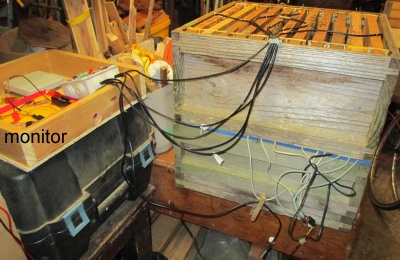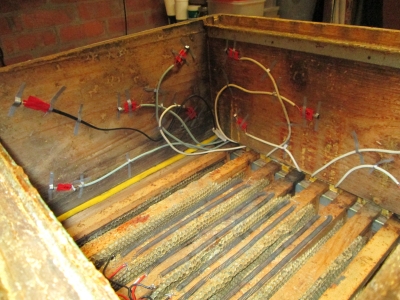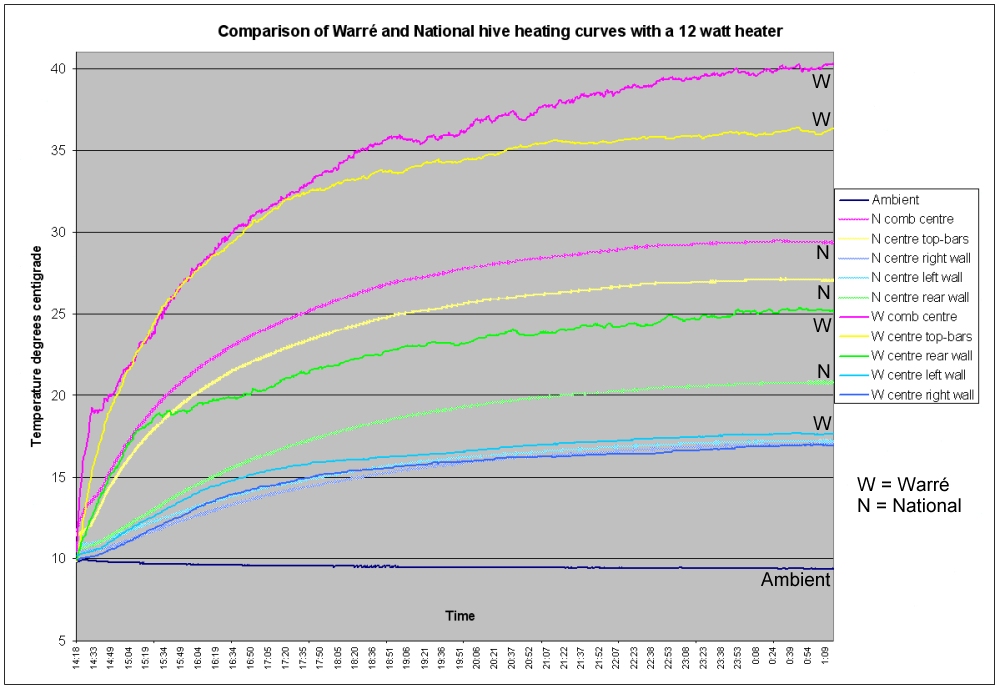
Comparison of thermal performances of Warré and National hives with combs
David Heaf, 9 December 2017
Summary
Two-box National and Warré hives each full of combs were heated for 11 hours with a heater of approximately 12 watts mounted between the boxes. Temperature changes were recorded on the surfaces of top boxes every 30 seconds with an Arduino-based monitor, and on the outside surfaced with an infra-red thermometer. Calculated heat dissipations from the boxes were similar, but at the warmest points the National hive was 11 degrees cooler than the Warré and showed much slower increases in temperature. Heat loss through the box walls was more even for the National than for the Warré. This was partly attributed to the bee spaces above and round the edges of the National frames thus creating greater freedom for convection and consequently equalisation of temperatures. Compared with the Warré hive, the National lost almost three times as much heat through its roof.
Introduction and methods
The thermometers and their use with a Warré hive are described here. The Warré hive data used here are derived from that investigation. Both hives were tested in the relatively still air conditions of an unheated garage. Ambient temperatures were in the range 9-10ºC.
A 2-box Warré was used with the heater on the top-bars of the second box. Here, for near equivalence, a National hive brood box was placed on a National super in a so-called 'brood and a half' configuration. There were nine nine framed combs in the super. In the brood box were seven framed combs, and outside of these were, on one side, a frame of foundation and a frame of corrugated cardboard, and on the opposite side, two frames containing corrugated cardboard making 11 frames in all. The cardboard was a substitute for empty comb as only seven of the latter were available.

The same approximately 12 watt heater as used in the Warré hive was placed in the centre of the top-bars of the National. Between the super and the brood boxes was a thin layer of foam to simulate a propolis airtight seal and to allow passage of 10 sensor wires while minimising draughts. The National was equipped with a mesh floor with a closed aluminium drawer under it, and a standard crown board with the customary two feed/ventilation holes, one central and one off centre. These holes were closed by a 6 mm thick wooden cover. Five 'naked' DS18B20 temperature sensors were fixed inside a side wall and a front wall of the brood box. The 11 frames were inserted and a further 6 encapsulated DS18B20 sensors were positioned amongst them or on top of them. The six wires were led out through a notch cut in the lower rim of the crown board. The edges of the notch were sealed with blutack. The crown board was fitted and its contact point with the brood box sealed with tape, again to simulate a propolis seal. A telescopic roof was fitted and weighted by two bricks.
 Left:
positioning of sensors on inner walls of a National brood box.
Left:
positioning of sensors on inner walls of a National brood box.
For the roof heat flow measurements, five sensors were attached under the crown board and a further five placed on the tops of the frame top-bars at corresponding positions below the sensors on the crown board. Six encapsulated sensors were placed at positions in the brood box similar to those used in the study of the Warré hive.

In the above chart, similar colours are chosen for the curves of sensors in equivalent positions in each hive. As expected from its smaller size, thicker walls and top insulation, the Warré hive heats up more quickly. One need only compare the pink, yellow and green curves (Warré) with their paler coloured equivalents (National). Furthermore, once equilibrium is reached the National; hive is up to 11 degrees cooler than the Warré. This is not unexpected, as Mitchell (2016) found that the National hive dissipated twice as much heat as the Warré for the same wattage heater.
The average temperature of the five sensors attached to the crown board of the National hive was 20.9ºC and those in corresponding positions below them on the top-bars was 22.4ºC. The 1.5ºC temperature difference emphasises the need to measure actual surface temperatures when measuring heat flow through them.
National hive data and thermal conductivities (Table 1)
| Wood | Western red cedar | |
Area of side wall 369 x 225 |
0.083 |
m2, frames cold-way |
Area of front/rear wall 425 x 225 |
0.096 |
m2 |
Area of roof |
0.181 |
m2, inside crown board battens |
Thickness of front/rear wall |
0.028 |
m, taking into account rebates |
Thickness of side wall |
0.0198 |
m |
Volume of hole cover 8.5x113x220 |
0.00021 |
m3 |
Thickness of plywood crown board |
0.0062 |
m |
Volume of crown board 0.181x.0062 |
0.0012 |
m3 |
Volume of crown board holes |
0.000029 |
m3 |
Average thickness of crown board |
0.0069 |
ply plus cover board minus holes |
Depth of roof cavity |
0.033 |
m |
Thickness of roof board |
0.021 |
m |
Thickness of aluminium |
0.001 |
m |
| Thermal conductivity cedar | 0.10 | W/m.K, Tenwolde et al. (1988) |
| Thermal conductivity plywood | 0.16 | W/m.K |
| Thermal conductivity | 237 | W/m.K |
Results
Table 2. Heat flows through National and Warré brood box surfaces |
|||||
National brood (on super) |
Warré (top box of two) |
||||
Watts |
% of total |
Watts |
% of total |
||
Side walls |
3.97 |
38.6 |
2.98 |
33.3 |
|
Front/back |
3.77 |
36.6 |
5.48 |
61.2 |
|
Roof |
1.45 |
14.1 |
0.49 |
5.5 |
|
Total |
9.19 |
8.95 |
|||
Considering Table 2: as expected from the similar geometries of each of these hive set-ups, i.e. two boxes with a 12 watt heater between them and both boxes filled with combs arranged cold-way, the observed total heat dissipated by each is reassuringly close, differing by only 0.24 watts. About one quarter of the heat unaccounted for is dissipated through the lower box, a shallow super in the case of the National hive.
As found in a previous thermal study on the Warré hive the heat lost through the front and rear walls of the Warré hive is nearly double that of the side walls. The thermal resistance through the comb faces as opposed to parallel to the combs in the beeways was suggested as the likely reason for this. But with the National hive there is very little difference in heat flows between front/back walls versus side walls. This could be partly due to the greater thickness of front/back walls (28 mm average) compared with side walls (20mm). However, a greater contribution to evening out the the flows in the two directions is that there is a bee space under the crown board of the National hive of about 6 mm and bee spaces at the ends of all the frames. Therefore, compared with the Warré hive, which has no top bee space and comb ends fixed to the walls, there is less obstruction of air circulation round the hive interior and thus greater opportunity for evening out temperature differences through convection.
A further point to note from Table 2 is that the heat lost through the roof of the National hive is almost three times that of the Warré. Part of this is no doubt due to the fact that the National roof, measured on the inside rim of the brood box, is double that of the Warré hive (0.18m2 versus 0.09m2). That the difference is not greater is no doubt attributable to the 33 mm air gap in the National roof and the low thermal conductivity of the air in it.
References
Mitchell, D. (2016). Ratios of colony mass to thermal conductance of tree and man-made nest enclosures of Apis mellifera: implications for survival, clustering, humidity regulation and Varroa destructor. International Journal of Biometeorology, 60(5), pp.629–638. Available at: http://dx.doi.org/10.1007/s00484-015-1057-z .
Tenwolde, A., McNatt, J. D. & Krahn, L. (1988) Thermal properties of wood and wood panel products for use in building. US Department of Energy.